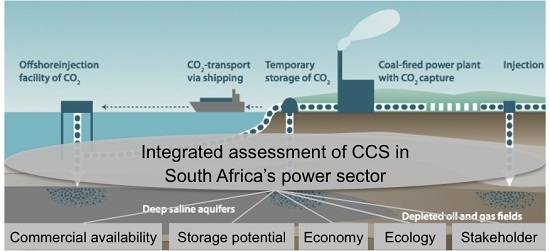Integrated Assessment of Carbon Capture and Storage (CCS) in South Africa’s Power Sector
Abstract
:1. Introduction
2. Methodology
- (A)
- The aim of the storage capacity assessment is to systematically analyze and compare existing capacity estimates for South Africa using the methodology linked to the “techno-economic resource-reserve pyramid for CO2 storage capacity” [19]. The resulting storage scenarios (S1–S3) represent the range between a high and a low estimate of the country’s storage potential.
- (B)
- An energy scenario analysis is used to estimate the amount of CO2 emissions that could potentially be captured from power plants by 2050. Based on existing long-term energy scenarios for South Africa, three long-term coal development pathways for power plants (E1–E3) are developed. They indicate a development between a “high carbon” and a “low carbon” strategy. The next step lays out hypotheses on how many of these power plants could be built or retrofitted with CO2 capture technologies. Finally, the quantity of CO2 that could be separated is calculated for the pathways assuming different parameters, such as the CO2 capture rate and the efficiency penalty. CO2 emissions are cumulated over the lifetime of all power plants newly built up to 2050. It should be noted that these pathways differ from energy scenarios: while energy scenarios provide a consistent framework for the analysis of long-term energy strategies, the pathways applied here are taken from different existing scenario studies. They are only used to illustrate different CCS development pathways to obtain an understanding of the level of separated CO2 emissions that could be available for storage.
- (C)
- In order to achieve a source-sink match, the storage scenarios are combined with the coal development pathways to obtain a total matched capacity for each combination of S1–S3 and E1–E3. The result is the matched capacity, which is the next step up in the storage pyramid concept. Due to missing data and the consequential heuristic approach, matching is performed manually without using a geographic information system.
- LCOE = levelized costs of electricity generation (LCOE) = USD/kWhel
- CCap = specific capital expenditure (CCap) = USD/kWel
- CO&M = specific operating and maintenance costs (CO&M) = USD/kWel
- af = annuity factor (af) = %/a
- I = real interest rate (I) = %
- n = depreciation period (n) = a
- CTS = specific cost of CO2 transportation and storage (CTS) = USD/kWhel
- Cfuel = specific fuel costs (including CO2 penalty) (Cfuel) = USD/kWhel
- Capacity = full load hours (capacity) = h/a
3. Results
3.1. The Commercial Availability of CCS Technology
3.2. The Long-Term Usable CO2 Storage Potential for South Africa’s Power Sector
3.2.1. An Analysis of Storage Potential for South Africa
| Formation | Storage capacity |
|---|---|
| Gt CO2 | |
| Oil fields | 0.0 |
| Gas fields | 0.1 |
| Onshore aquifers* | 0.8 |
| Offshore aquifers* | 147.7 |
| Coal seams | 1.3 |
| Total | 149.9 |
| Formation | Basin | S1*: high | S2*: intermediate | S3*: low | Distance from emission cluster | |||
|---|---|---|---|---|---|---|---|---|
| Gt CO2 | km | |||||||
| Oil | - | - | - | |||||
| Gas | 0.2 | - | - | > 1,000 | ||||
| Onshore aquifers | Algoa Zululand | 0.4 0.4 | 0.8 | 0.2 0.2 | 0.4 | - - | 900 300–500 | |
| Offshore aquifers | Outeniqua Orange Durban & Zululand | 48.4 57.1 42.3 | 147.8 | 19.3 22.8 16.9 | 59.0 | 4.8 5.7 4.2 | 14.7 | > 1,000 > 1,200 450–600 |
| Total | 148.8 | 59.4 | 14.7 | > 1,000 | ||||
3.2.2. Deriving the Amount of CO2 That May Be Captured in South Africa’S Power Sector
- 1
- Pathway E1: high is based on the Long-Term Mitigation Scenario (LTMS) No. 1 “Growth Without Constraints” [37,38], which involves neither a change from current trends nor the implementation of existing policies. It assumes an increase in installed power plant capacity from the current level of 37 GW to 120 GW by 2050, with a decreasing share of coal (91 GW by 2050) and an increasing share of nuclear energy (17 GW by 2050).
- 2
- Pathway E2: middle is based on the “Reference Scenario” as developed in the Sustainable Energy Outlook for South Africa ([35], see description of pathway E3: low). Originally based on the World Energy Outlook 2008 Reference Scenario [39], which takes into account existing international energy and environmental policies, this has been updated with governmental power plant planning according to the Policy Adjusted Scenario of the IRP [26]. It was then extrapolated from 2035 to 2050. The scenario envisages a peak of coal power plant capacity of 45 GW in 2030, an increase in nuclear power (12 GW in 2050) and a strong increase in renewable capacity (37 GW in 2050).
- 3
- Pathway E3: low is based on the Sustainable Energy Outlook for South Africa [35]. The South African scenario is part of the global Energy [R]evolution Scenario framework, the target of which is to reduce worldwide CO2 emissions to 50% below 1990 levels by 2050. While the scenario is based on renewable energy sources, efficient decentralized cogeneration and energy-saving technologies, both CCS power plants and nuclear power plants are excluded. In contrast to the Reference Scenario outlined above, this scenario considers only committed coal power plants as given in the IRP, and does not envisage any further new coal-fired power stations from 2020 on.

- In E1: high the deployment of CCS would have to be as high as possible in the future to decrease the CO2 emissions resulting from this pathway in accordance with the long-term climate protection target of the international community to which South Africa is increasingly committing itself [25].
- In both E2: middle and E3: low the deployment of CCS could be a “fall back” option which may have to be used if other measures to reduce power sector CO2 emissions cannot be realized as envisaged in the respective scenarios (usually the considerable use of nuclear energy and renewable energies in E2: middle and energy efficiency improvements and renewable energy deployment in E3: low).
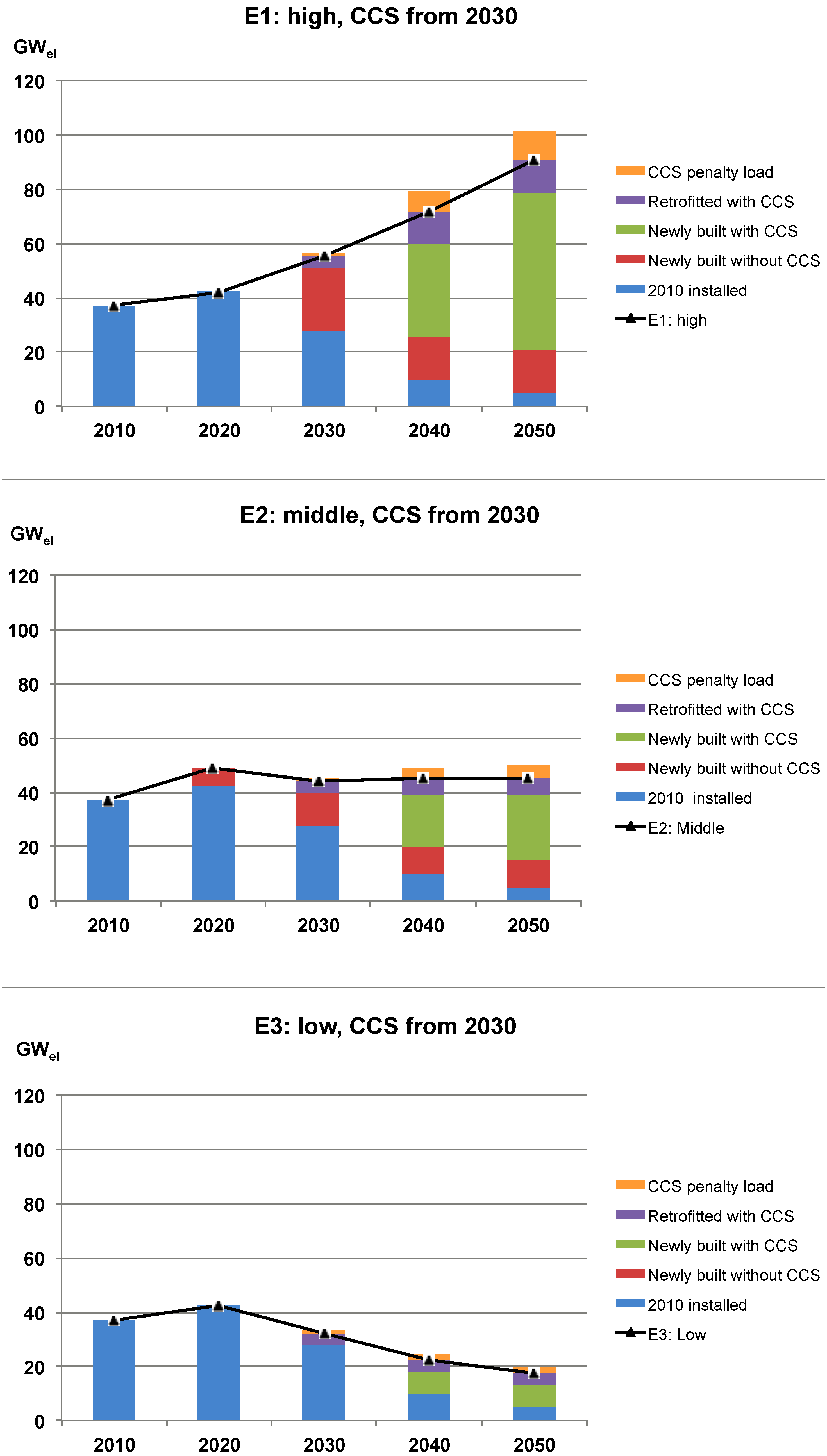
| Parameter | 2010 | 2020 | 2030 | 2040 | 2050 | |
|---|---|---|---|---|---|---|
| Efficiency of newly built supercritical coal fired power plant | % | 38 | 39 | 41.5 | 42 | 42 |
| Efficiency of newly built IGCC | % | 44 | 46.5 | 47 | ||
| Efficiency penalty post-combustion | %-pt | 12 | 8.5 | 7 | 6 | 5 |
| Efficiency penalty pre-combustion | %-pt | 8 | 6.5 | 6 | 6 | 6 |
| Additional efficiency penalty for retrofitting | %-pt | 1.5 | 1.5 | 1.5 | 1.5 | 1.5 |
| Availability of CCS | 7,000 full load hours (base case) | 6,000 full load hours (sensitivity case PLF) | ||||
|---|---|---|---|---|---|---|
| E1: high | E2: middle | E3: low | E1: high | E2: middle | E3: low | |
| Gt CO2 | Gt CO2 | |||||
| CCS from 2030 (base case) | 22.0 | 9.3 | 4.0 | 18.8 | 8.0 | 3.5 |
| CCS from 2035 (sensitivity case AV1) | 17.1 | 6.6 | 2.5 | 14.7 | 5.7 | 2.1 |
| CCS from 2040 (sensitivity case AV2) | 12.3 | 3.9 | 1.0 | 10.5 | 3.4 | 0.8 |
3.2.3. Deriving South Africa’s CCS Potential As a Result of Matching Sources and Sinks

| Formation | Basin | S1*600km: high | S2*600km: intermediate | S3*600km: low | Distance from emission cluster |
|---|---|---|---|---|---|
| Gt CO2 | km | ||||
| Onshore aquifers | Zululand | 0.4 | 0.2 | - | 300–500 |
| Offshore aquifers | Durban & Zululand | 42.3 | 16.9 | 4.2 | 450–600 |
| Total | 42.7 | 17.1 | 4.2 | 300–600 | |
| Power plant emissions from coal development pathways | |||
| Effective storage capacity scenarios * for matching | E1: high (22.0 Gt CO2) | E2: middle (9.3 Gt CO2) | E3: low (4.0 Gt CO2) |
| Matched capacity (Gt of CO2) | |||
| S1600km: high (43 Gt CO2) | 22.0 | 9.3 | 4.0 |
| S2600km: intermediate (17 Gt CO2) | 17.1 | 9.3 | 4.0 |
| S3600km: low (4 Gt CO2) | 4.2 | 4.2 | 4.0 |
| Share of effective storage capacity used (%) | |||
| S1600km: high (43 Gt CO2) | 51 | 22 | 9 |
| S2600km: intermediate (17 Gt CO2) | 100 | 55 | 24 |
| S3600km: low (4 Gt CO2) | 100 | 100 | 100 |
| Share of emissions that can be stored (%) | |||
| S1600km: high (43 Gt CO2) | 100 | 100 | 100 |
| S2600km: intermediate (17 Gt CO2) | 78 | 100 | 100 |
| S3600km: low (4 Gt CO2) | 19 | 45 | 100 |
3.3. An Economic Assessment of CCS in South Africa’s Power Sector
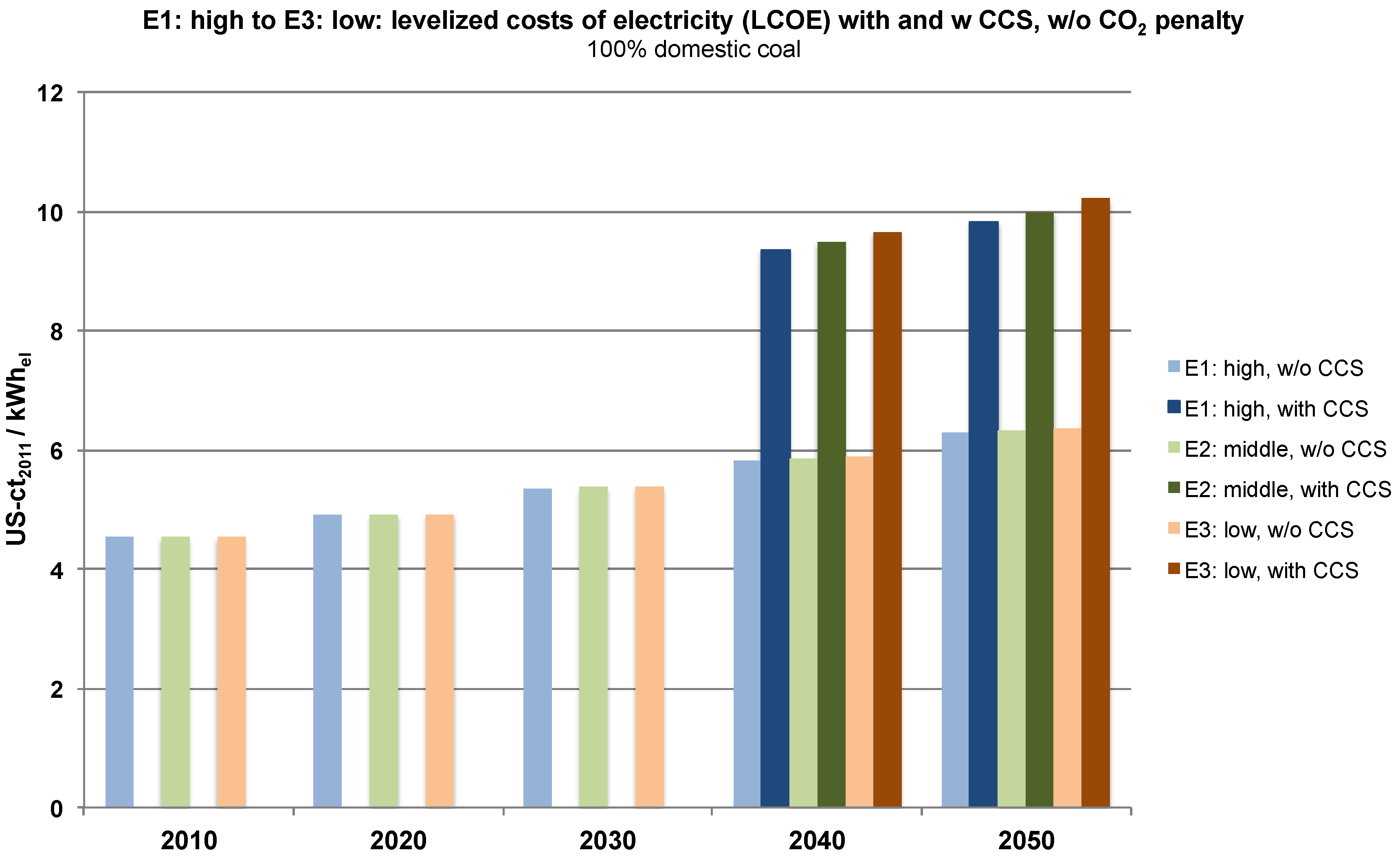
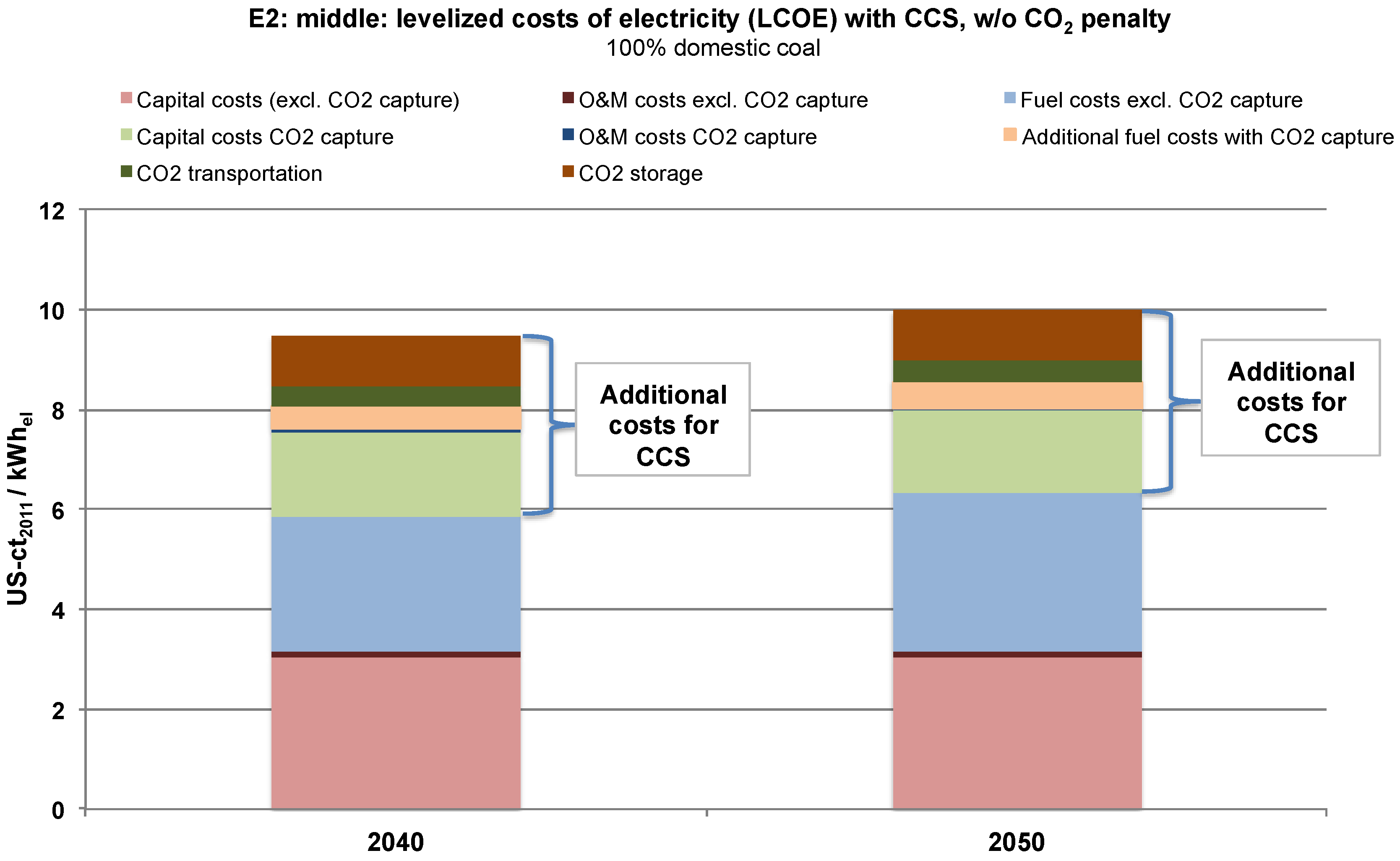
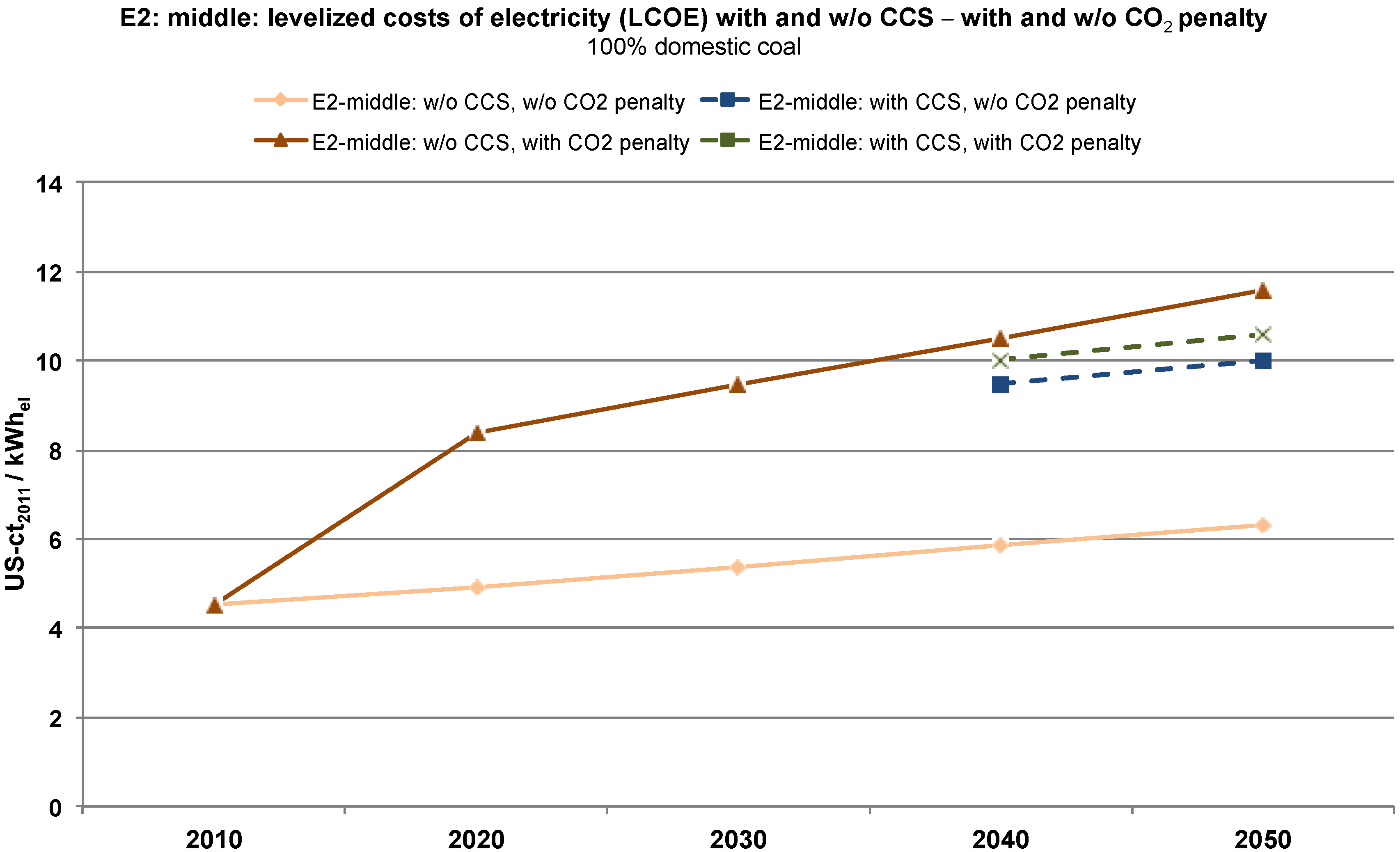
3.4. Environmental Impacts of CCS-Based Power Plants From a Life Cycle Assessment Perspective
- The excess consumption of fuels (energy penalty) required by the use of CCS technology. It causes more CO2 emissions, with the consequence that separated CO2 emissions are higher than avoided CO2 emissions;
- The CO2 emissions released into the upstream and downstream parts of the system, which are the provision of additional fuel and further processes such as the production of solvents or the transportation and storage of CO2;
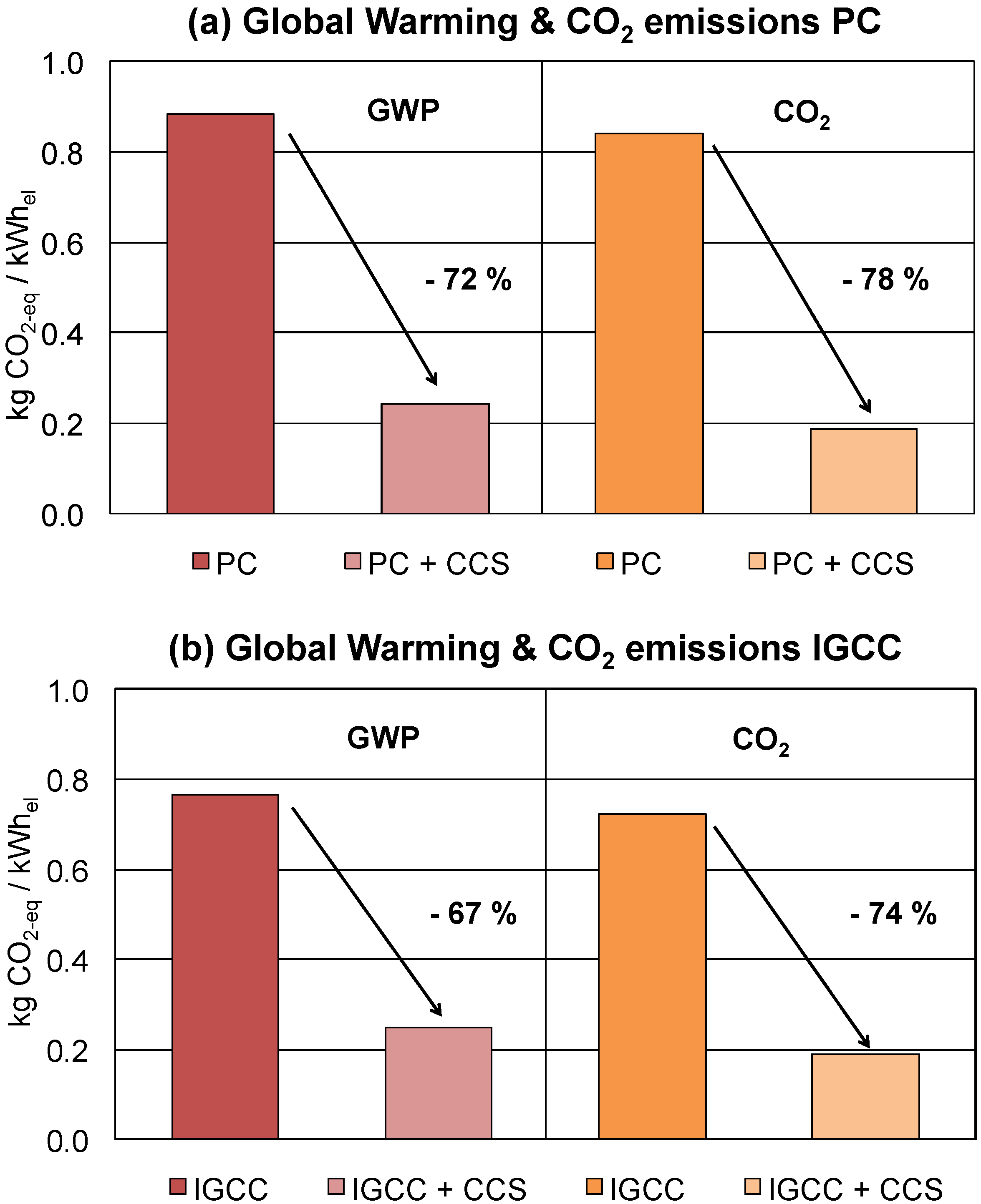
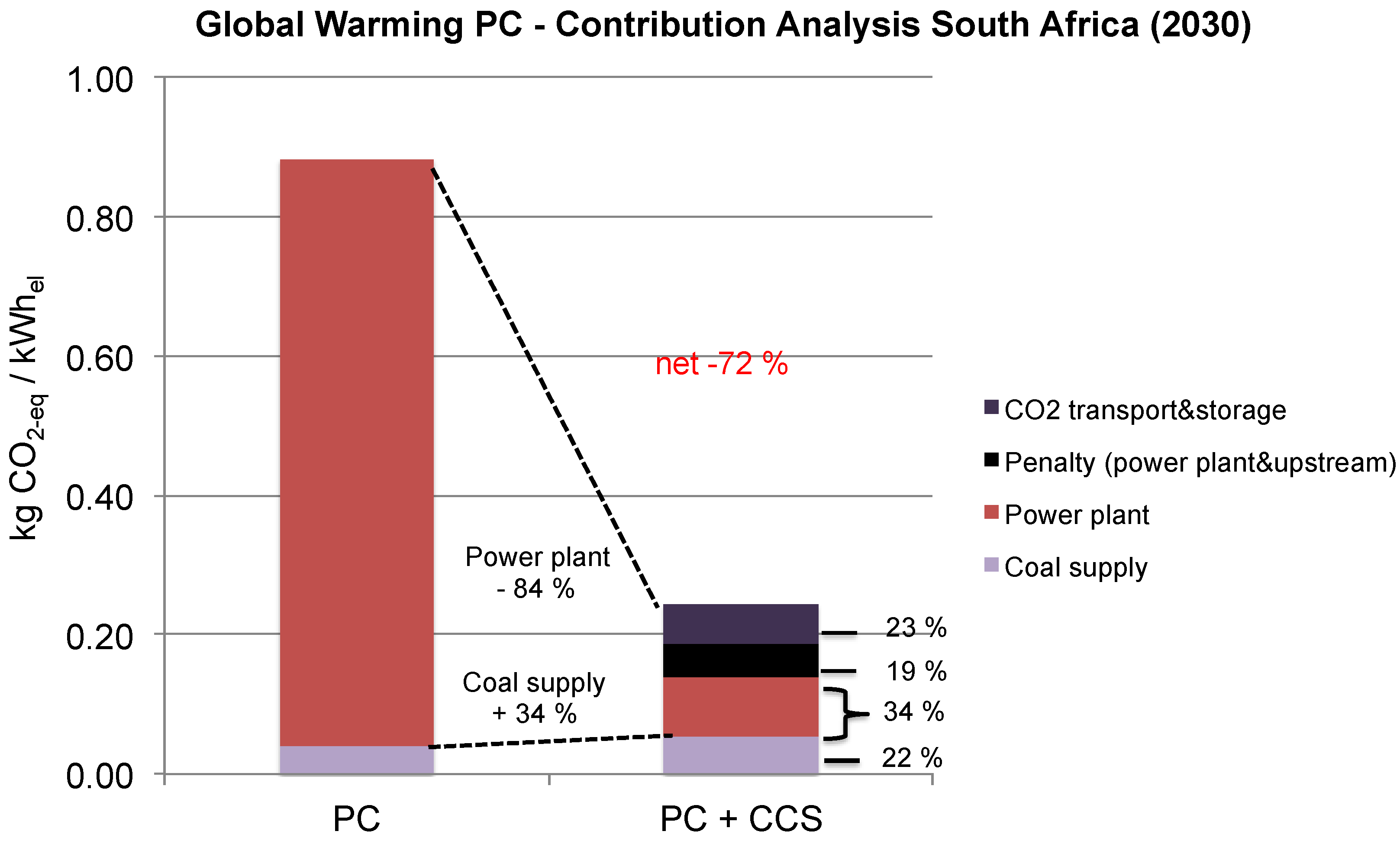
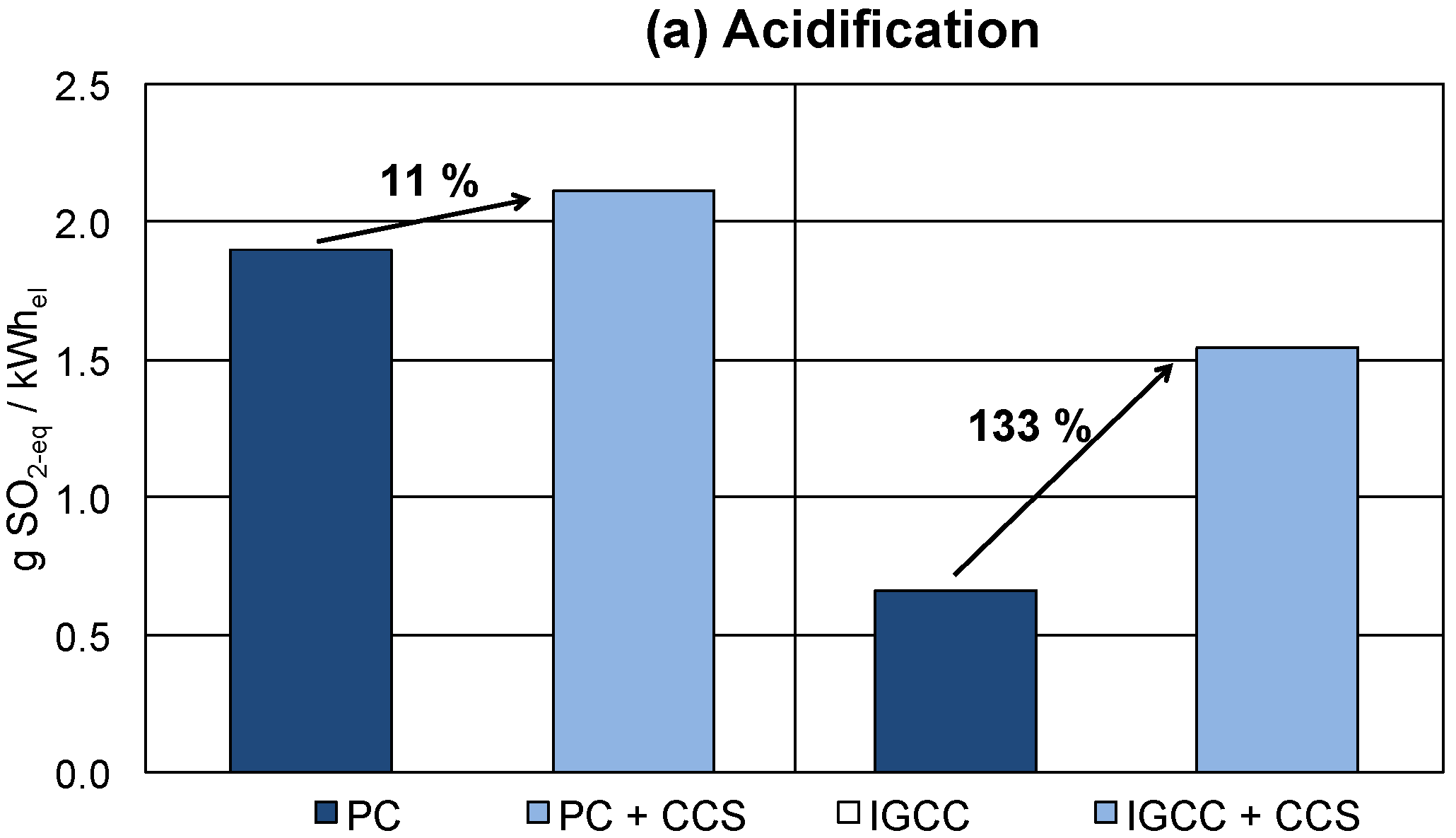
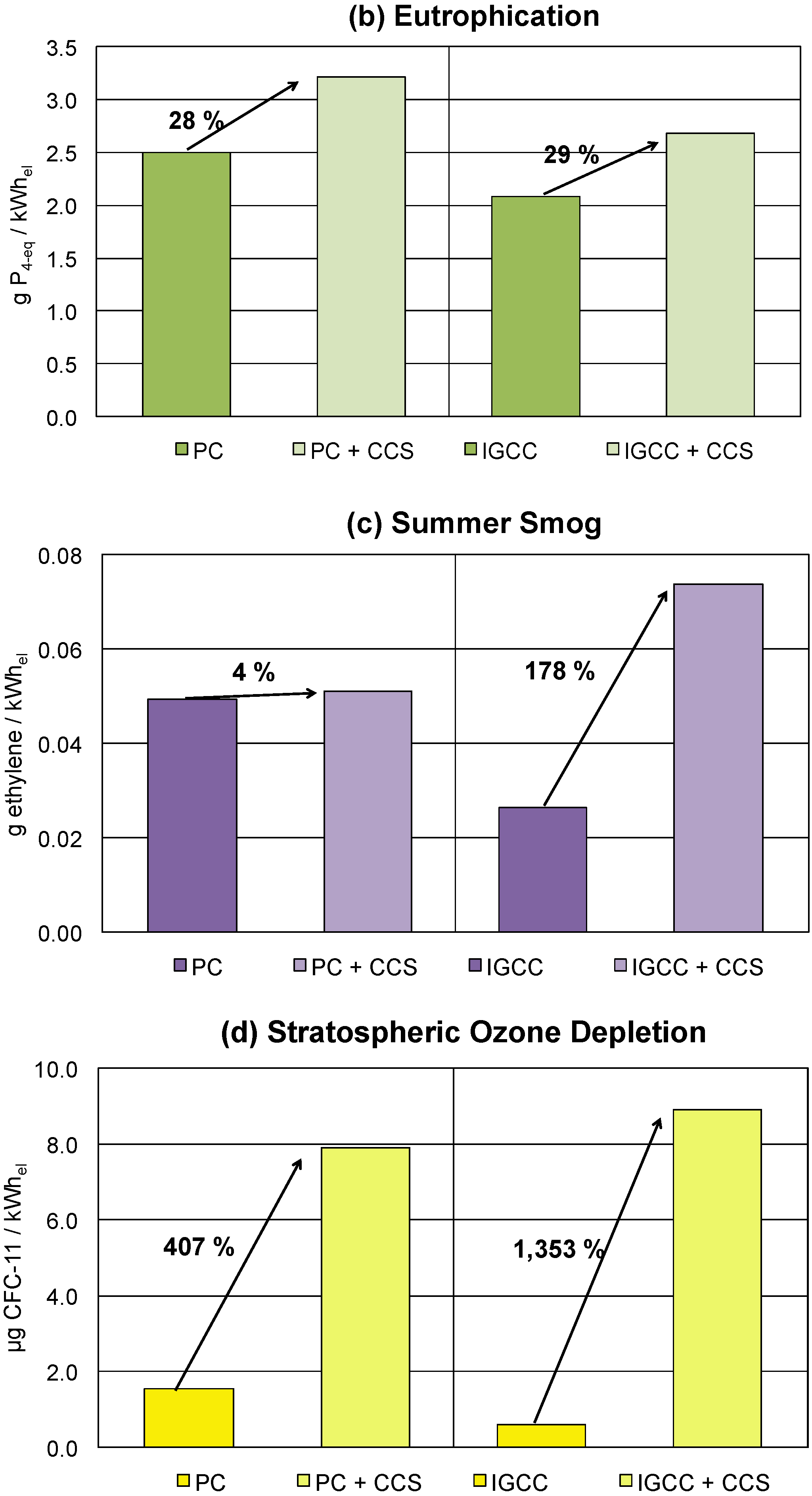
3.5. An Analysis of Stakeholder Positions
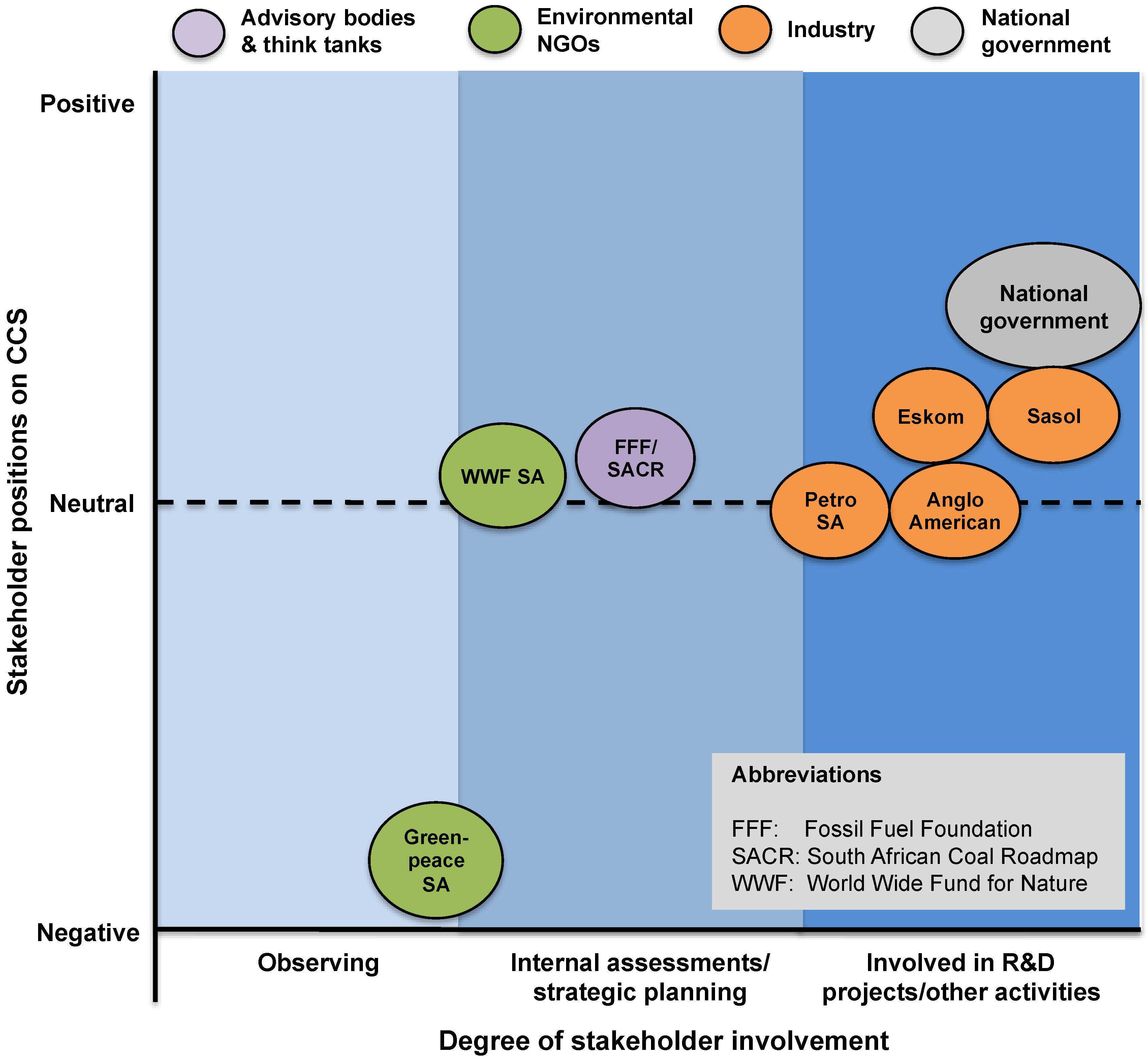
4. Discussion
5. Conclusions
Supplementary Materials
Acknowledgments
Author Contributions
Conflicts of Interest
References
- Viebahn, P.; Vallentin, D.; Höller, S. Prospects of carbon capture and storage (CCS) in India’s power sector—An integrated assessment. Appl. Energy 2014, 117, 62–75. [Google Scholar] [CrossRef]
- Viebahn, P.; Vallentin, D.; Höller, S. Prospects of carbon capture and storage (CCS) in China’s Power Sector—An integrated assessment. Appl. Energy 2015, 157, 229–244. [Google Scholar] [CrossRef]
- International Energy Agency (IEA). Energy Technology Perspectives 2015: Mobilising Innovation to Accelerate Climate Action; International Energy Agency: Paris, France, 2015. [Google Scholar]
- Intergovernmental Panel on Climate Change (IPCC). Climate Change 2014. IPCC Fifth Assessment Report (AR5); Intergovernmental Panel on Climate Change: Geneva, Switzerland, 2014. [Google Scholar]
- Beyond Petroleum (BP). BP Statistical Review of World Energy; Beyond Petroleum: London, UK, 2014. [Google Scholar]
- City Research. The Unimaginable: Peak Coal in China; Citygroup Global Markets Inc.: New York, NY, USA, 2013. [Google Scholar]
- International Energy Agency (IEA). Energy Technology Perspectives 2010: Scenarios and Strategies to 2050; International Energy Agency: Paris, France, 2010. [Google Scholar]
- International Energy Agency (IEA). Power Generation from Coal: Ongoing Developments and Outlook; Information Paper; International Energy Agency: Paris, France, 2011. [Google Scholar]
- European Commission. Consultative Communication on The Future of Carbon Capture and Storage in Europe; COM(2013) 180 final; European Commission: Brussels, Belgium, 2013. [Google Scholar]
- Beck, B.; Surridge, T.; Liebenberg, J.; Gilder, A. The current status of CCS development in South Africa. Energy Procedia 2011, 4, 6157–6162. [Google Scholar] [CrossRef]
- Condor, J.; Unatrakarna, D.; Asghari, K.; Wilson, M. Current status of CCS Initiatives in the major emerging economies. Energy Procedia 2011, 4, 6125–6132. [Google Scholar] [CrossRef]
- Román, M. Carbon capture and storage in developing countries: A comparison of Brazil, South Africa and India. Global Environ Change 2011, 21, 391–401. [Google Scholar] [CrossRef]
- Vincent, C.J.; Hicks, N.; Arenstein, G.; Tippmann, R.; van der Spuy, D.; Viljoen, J.; Davids, S.; Roos, M.; Cloete, M.; Beck, B.; et al. The proposed CO2 test injection project in South Africa. Energy Procedia 2013, 37, 6489–6501. [Google Scholar] [CrossRef]
- Telsnig, T.; Tomaschek, J.; Özdemir, E.D.; Bruchof, D.; Fahl, U.; Eltrop, L. Assessment of selected CCS technologies in electricity and synthetic fuel production for CO2 mitigation in South Africa. Energy Policy 2013, 63, 168–180. [Google Scholar] [CrossRef]
- Hicks, N.; Davids, S.; Beck, B.; Green, A. Investigation of CO2 storage potential of the Durban Basin in South Africa. Energy Procedia 2014, 63, 5200–5210. [Google Scholar] [CrossRef]
- Chabangu, N.; Beck, B.; Hicks, N.; Viljoen, J.; Davids, S.; Cloete, M. The investigation of CO2 storage potential in the Algoa Basin in South Africa. Energy Procedia 2014, 63, 2800–2810. [Google Scholar] [CrossRef]
- Chabangu, N.; Beck, B.; Hicks, N.; Botha, G.; Viljoen, J.; Davids, S.; Cloete, M. The investigation of CO2 storage potential in the Zululand Basin in South Africa. Energy Procedia 2014, 63, 2789–2799. [Google Scholar] [CrossRef]
- Middleton, R.S.; Eccles, J.K. The complex future of CO2 capture and storage: Variable electricity generation and fossil fuel power. Appl. Energy 2013, 108, 66–73. [Google Scholar] [CrossRef]
- Bachu, S. Carbon dioxide storage capacity in uneconomic coal beds in Alberta, Canada: Methodology, potential and site identification. Int. J. Greenh. Gas Control 2007, 1, 374–385. [Google Scholar] [CrossRef]
- Guinée, J.B.; Gorrée, M.; Heijungs, R.; Huppes, G.; Kleijn, R.; de Koning, A.; van Oers, L.; Sleeswijk, A.; Suh, S.; de Haes, H.A.U.; et al. Handbook on Life Cycle Assessment: Operational Guide to the ISO Standards; Kluwer: Dordrecht, The Netherlands, 2002. [Google Scholar]
- Viebahn, P.; Vallentin, D.; Höller, S. Integrated assessment of carbon capture and storage (CCS) in the German power sector and comparison with the deployment of renewable energies. Appl. Energ. 2012, 97, 238–248. [Google Scholar] [CrossRef]
- von Hirschhausen, C.; Herold, J.; Oei, P.-Y. How a “low carbon” innovation can fail: Tales from a “lost decade” for carbon capture, transport, and sequestration (CCTS). Econ. Eenergy Environ. Policy 2012, 1, 115–123. [Google Scholar] [CrossRef]
- Chen, Q.; Rennings, K. Low carbon scenarios vs. clean coal scenarios in China: How to close the carbon gap? Appl. Mech. Mater. 2014, 556–562, 841–848. [Google Scholar] [CrossRef]
- Zhu, L.; Fan, Y. A real options—Based CCS investment evaluation model: Case study of China’s power generation sector. Appl. Energy 2011, 88, 4320–4333. [Google Scholar] [CrossRef]
- Government SA. National Development Plan 2030; Government of the Republic of South Africa: Pretoria, South Africa, 2014.
- Department of Energy. Electriciy Regulation Act No. 4 of 2006: Electricity regulations on the integrated resource plan 2010–2030; Ministry of Energy, Government of South Africa: Pretoria, South Africa, 2011.
- Beck, B. An update on the South African pilot CO2 storage project. Energy Procedia 2014, 63, 6188–6193. [Google Scholar] [CrossRef]
- Cloete, M. Atlas on Geological Storage of Carbon Dioxide in South Africa; Council for Geoscience South Africa: Pretoria, South Africa, 2010. [Google Scholar]
- Viljoen, J.H.A.; Stapelberg, F.D.J.; Cloete, M. Technical Report on the Geological Storage of Carbon Dioxide in South Africa; Council for Geoscience South Africa: Pretoria, South Africa, 2010. [Google Scholar]
- Viljoen, J.; Stapelberg, F.D.J.; Cloete, M. The atlas on geological storage of CO2 in South Africa. In Proceedings of the 2nd South African CCS Week, Johannesburg, South Africa, 2011.
- South African Centre for Carbon Capture and Storage (SACCCS). Transcript of two interviews with representatives. In Proceedings of The South African Centre for Carbon Capture and Storage, Johannesburg, South Africa, 24–25 October 2011.
- Sasol. Transcript of an interview with Two Representatives of Sasol; Sasol: Johannesburg, South Africa, 24 October 2011. [Google Scholar]
- Li, X.; Fang, Z. Current status and technical challenges of CO2 storage in coal seams and enhanced coal bed methane recovery: An overview. Int J. Coal Sci. Technol. 2014, 1, 93–102. [Google Scholar] [CrossRef]
- Kulichenko, N.; Ereira, E. Carbon Capture and Storage in Developing Countries: A Perspective on Barriers to Development; Energy and Mining Sector Board Discussion Paper, Report 25; The World Bank: Washington, DC, USA, 2011. [Google Scholar]
- European Renewable Energy Council, Greenpeace International. Advanced Energy [R]evolution: A Sustainable Energy Outlook for South Africa; European Renewable Energy Council, Greenpeace International: Amsterdam, The Netherlands, 2011; p. 108. [Google Scholar]
- World Wide Fund for Nature (WWF). 50% by 2030. In Renewable Energy in a Just Transition to Sustainable Electricity Supply; WWF South Africa: Rosebank, South Africa, 2010. [Google Scholar]
- Scenario Building Team. Long-Term Mitigation Scenarios: Strategic Options for South Africa; Department of Environment Affairs and Tourism South Africa: Pretoria, South Africa, 2007. [Google Scholar]
- Energy Research Centre. Long-Term Mitigation Scenarios: Technical Appendix; Department of Environment Affairs and Tourism: Pretoria, South Africa, 2007.
- International Energy Agency (IEA). World Energy Outlook 2008; International Energy Agency: Paris, France, 2008. [Google Scholar]
- Tot, M.; Pesut, D.; Hudges, A.; Fedorski, C.; Merven, B.; Trikam, A.; Duerinck, J.; Ferket, H.; Lust, A. Techno-Economic Assessment of Carbon Capture and Storage Deployment in Power Stations in the Southern African and Balkan Regions; vito, Energelski institut Hrvoje Pozar, University of Cape Town: Cape Town, South Africa, 2011. [Google Scholar]
- International Energy Agency (IEA). World Energy Outlook 2014; International Energy Agency: Paris, France, 2014. [Google Scholar]
- Eskom. Transcript of an interview with a Representative of Eskom; Eskom: Johannesburg, South Africa, 27 October 2011. [Google Scholar]
- Hughes, A.; Haw, M.; Winkler, H.; Marquard, A.; Merven, B. Energy Emissions: A Modelling Input Into the Long Term Mitigation Scenarios Process; LTMS Input Report, Report 1; Energy Research Centre: Cape Town, South Africa, 2007. [Google Scholar]
- Minchener, A. Developments in China’s Coal-Fired Power Sector; CCC, Report 163; IEA Clean Coal Centre: London, UK, 2010. [Google Scholar]
- McKinsey. Carbon Capture and Storage: Assessing the Economics; McKinsey & Company: Summit, NJ, USA, 2008. [Google Scholar]
- Alstom. Zukunftsdialog: Kostenabschätzung Fossiler Kraftwerke Mit Und Ohne CCS-Ausrüstung (Alstom Future Dialog: Cost Estimation of Fossil Fired Power Plants with and without CCS); Alstom: Saint-Ouen, France, 2011. [Google Scholar]
- Rochedo, P.R.R.; Szklo, A. Designing learning curves for carbon capture based on chemical absorption according to the minimum work of separation. Appl. Energy 2013, 108, 383–391. [Google Scholar] [CrossRef]
- Kunze, C.; Spliethoff, H. Assessment of oxy-fuel, pre- and post-combustion-based carbon capture for future IGCC plants. Appl. Energy 2012, 94, 109–116. [Google Scholar] [CrossRef]
- Martelli, E.; Kreutz, T.; Carbo, M.; Consonni, S.; Jansen, D. Shell coal IGCCS with carbon capture: conventional gas quench vs. innovative configurations. Appl. Energy 2011, 88, 3978–3989. [Google Scholar] [CrossRef]
- Blignaut, J.; Koch, S.; Riekert, J.; Inglesi-Lotz, R.; Nkambule, N. The External Cost of Coal-Fired Power Generation: The Case of Kusile; Business Enterprises University of Pretoria: Hatfield, South Africa, 2011. [Google Scholar]
- Eskom. Fact Sheet Medupi Power Station; Eskom: Johannesburg, South Africa, 2012. [Google Scholar]
- Eskom. Status Report on Capacity Expansion Projects—New Build Programme; Eskom: Johannesburg, South Africa, 2011. [Google Scholar]
- Intergovernmental Panel on Climate Change (IPCC). Special report on carbon dioxide capture and storage. In Prepared by Working Group III of the Intergovernmental Panel on Climate Change; Metz, B., Davidson, O., de Coninck, H., Loos, M., Meyer, L., Eds.; Cambridge University Press: Cambridge, NY, USA, 2005. [Google Scholar]
- Council for Geoscience. Transcript of an interview with a Representative of the Council for Geoscience; Council for Geoscience: Johannesburg, South Africa, 28 October 2011. [Google Scholar]
- International Energy Agency, OECD Nuclear Energy Agency. Projected Costs of Generating Electricity; International Energy Agency, OECD Nuclear Energy Agency: Paris, France, 2010. [Google Scholar]
- Newbery, P.; Eberhard, A. South African Network Infrastructure Review: Electricity; University of Cape Town: Cambridge, Cape Town, South Africa, 2008. [Google Scholar]
- Finkenrath, M. Cost and Performance of Carbon Dioxide Capture from Power Generation; International Energy Agency: Paris, France, 2011. [Google Scholar]
- Massachusetts Institute of Technology. The Future of Coal: Options for a Carbon-Constrained World; Massachusetts Institute of Technology: Boston, MA, USA, 2007. [Google Scholar]
- Global CCS (Carbon Capture and Storage) Institute. Economic Assessment of Carbon Capture and Storage Technologies. Strategic Analysis of the Global Status of Carbon Capture and Storage; Global CCS Institute: Canberra, Australia, 2009. [Google Scholar]
- Viebahn, P.; Esken, A.; Höller, S.; Luhmann, H.-J.; Pietzner, K.; Vallentin, D. RECCS plus: Comparison of Renewable Energy Technologies (RE) with Carbon Dioxide Capture and Storage (CCS): German Federal Ministry for the Environment, Nature Conservation and Nuclear Safety; Wuppertal Inst. for Climate, Environment and Energy: Wuppertal, Germany, 2010; p. 306. [Google Scholar]
- IEAGHG. Estimating the Future Trends in the Cost of CO2 Capture Technologies; Report 6; International Energy Agency Greenhouse Gas R&D Programme: Cheltenham, UK, 2006. [Google Scholar]
- Eberhard, A. The Future of South African Coal: Market, Investment and Policy Challenges; Stanford University: Stanford, CA, USA, 2011. [Google Scholar]
- McCoy, S.T. The Economics of CO2 Transport by Pipeline and Storage in Saline Aquifers and Oil Reservoirs. Ph.D. Thesis, Carnegie Mellon University, Pittsburgh, PA, USA, 2008. [Google Scholar]
- Vidas, H.; Hugman, R.; Clapp, C. Analysis of geologic sequestration costs for the United States and implications for climate change mitigation. Energy Procedia 2009, 1, 4281–4288. [Google Scholar] [CrossRef]
- Zheng, B.; Xu, J. Carbon capture and storage development trends from a techno-paradigm perspective. Energies 2014, 7, 5221–5250. [Google Scholar] [CrossRef]
- The Carbon Report. The proposed South African carbon tax. How will the proposed carbon tax policy affect your business? Available online: http://www.thecarbonreport.co.za/the-proposed-south-african-carbon-tax/ (accessed on 17 July 2015).
- Government SA. National Climate Change Response White Paper; Government of the Republic of South Africa: Pretoria, South Africa, 2011.
- (Bundesministerium für Umwelt) BMU. Langfristszenarien Und Strategien Für Den Ausbau Erneuerbarer Energien in Deutschland: Leitszenario 2009 (Long-Term Scenarios and Strategies for the Deployment of Renewable Energies in Germany: Lead Scenario 2009); Umweltpolitik; Bundesministerium für Umwelt, Naturschutz und Reaktorsicherheit: Berlin, Germany, 2009; p. 105. [Google Scholar]
- Deibl, C. Life Cycle Assessment (LCA) of Future Coal-Fired Power Plants Based on Carbon Capture and Storage (CCS)—the Case of China, India and South Africa. Master Thesis, Technical University of Munich and Wuppertal, Wuppertal, Germany, November 2011. [Google Scholar]
- Munyai, N.; Beck, B.; Surridge, T.; van den Berg, T.; Motloung, D. On potential showstoppers for carbon capture and storage (CCS) in South Africa. Energy Procedia 2013, 37, 6458–6463. [Google Scholar] [CrossRef]
- Fossil Fuel Foundation. Transcript of an interview with a Representative of the Fossil Fuel Foundation; Fossil Fuel Foundation: Johannesburg, South Africa, 26 October 2011. [Google Scholar]
- Department of Energy (DOE). Speech of the General Director of the Department of Energy of the Republic of South Africa at the 2nd South African CCS Week; Department of Energy: Johannesburg, South Africa, 2011.
- MacColl, B. Carbon capture and storage: Strategic considerations for Eskom. In Proceedings of the 2nd South African CCS Week, Johannesburg, South Africa, 24–28 October 2011.
- Anglo American. Climate Change: A Real Strategy for a Real Future; Anglo American: Johannesburg, South Africa, 2011. [Google Scholar]
- Greenpeace. Greenpeace Africa Submission on the Draft National Climate Change Response Paper—February 2011; Greenpeace Africa: Johannesburg, South Africa, 2011. [Google Scholar]
- WWF South Africa. Carbon Budget. In An NGO Perspective on Carbon Capture and Storage by Richard Worthington; WWF South Africa: Johannesburg, South Africa, 2011. [Google Scholar]
- Modiko, P.; Ngcobo, W.; Tshivhase, T.; Raselavhe, R.; Surridge, T.; Beck, B. The unique challenges for CCS public engagement in South Africa. Energy Procedia 2014, 63, 7047–7052. [Google Scholar] [CrossRef]
- Ricci, O.; Selosse, S. Global and regional potential for bioelectricity with carbon capture and storage. Energy Policy 2013, 52, 689–698. [Google Scholar] [CrossRef]
- Kong, Y.; Dong, X.; Xu, B.; Li, R.; Yin, Q.; Song, C. EROI analysis for direct coal liquefaction without and with CCS: The case of the Shenhua DCL project in China. Energies 2015, 8, 786–807. [Google Scholar] [CrossRef]
- Glazewski, J.; Gilder, A.; Swanepoel, E. Carbon Capture and Storage (CCS): Towards a regulatory and legal regime in South Africa; Institute of Marine and Environmental Law (IMEL) and African Climate and Development Initiative (ACDI), University of Cape Town: Cape Town, South Africa, 2012. [Google Scholar]
- Beyond Petroleum (BP). BP Statistical Review of World Energy; Summary of Energy Statistics, Beyond Petroleum: London, UK, 2010. [Google Scholar]
- Viebahn, P.; Esken, A.; Höller, S.; Vallentin, D. CCS Global—Prospects of Carbon Capture and Storage Technologies (CCS) in Emerging Economies; Wuppertal Inst. for Climate, Environment and Energy: Wuppertal, Germany, 2012; p. 550. [Google Scholar]
- Viebahn, P. Life cycle assessment for power plants with CCS. In Efficient Carbon Capture for Coal Power Plants; Stolten, D., Scherer, V., Eds.; Wiley-VCH: Weinheim, Germany, 2011; pp. 83–109. [Google Scholar]
- Singh, B.; Strømman, A.H.; Hertwich, E.G. Comparative life cycle environmental assessment of CCS technologies. Int. J. Greenh. Gas Control 2011, 5, 911–921. [Google Scholar] [CrossRef]
- Schreiber, A.; Zapp, P.; Marx, J. Meta-analysis of life cycle assessment studies on electricity generation with carbon capture and storage. J. Ind. Ecol. 2012, 16, S155–S168. [Google Scholar] [CrossRef]
- United Nations Framework Convention on Climate Change (UNFCC). South Africa’s Intended Nationally Determined Contribution (INDC); United Nations Framework Convention on Climate Change: Bonn, Germany, 2015. [Google Scholar]
- Altieri, K.; Trollip, H.; Caetano, T.; Hughes, A.; Merven, B.; Winkler, H. Pathways to Deep Decarbonization in South Africa; Sustainable Solutions Network (SDSN), Institute for Sustainable Development and International Relations (IDDRI): Paris, France, 2015. [Google Scholar]
© 2015 by the authors; licensee MDPI, Basel, Switzerland. This article is an open access article distributed under the terms and conditions of the Creative Commons by Attribution (CC-BY) license (http://creativecommons.org/licenses/by/4.0/).
Share and Cite
Viebahn, P.; Vallentin, D.; Höller, S. Integrated Assessment of Carbon Capture and Storage (CCS) in South Africa’s Power Sector. Energies 2015, 8, 14380-14406. https://doi.org/10.3390/en81212432
Viebahn P, Vallentin D, Höller S. Integrated Assessment of Carbon Capture and Storage (CCS) in South Africa’s Power Sector. Energies. 2015; 8(12):14380-14406. https://doi.org/10.3390/en81212432
Chicago/Turabian StyleViebahn, Peter, Daniel Vallentin, and Samuel Höller. 2015. "Integrated Assessment of Carbon Capture and Storage (CCS) in South Africa’s Power Sector" Energies 8, no. 12: 14380-14406. https://doi.org/10.3390/en81212432
APA StyleViebahn, P., Vallentin, D., & Höller, S. (2015). Integrated Assessment of Carbon Capture and Storage (CCS) in South Africa’s Power Sector. Energies, 8(12), 14380-14406. https://doi.org/10.3390/en81212432




